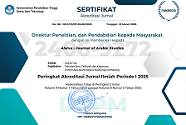Metode Komunikatif dengan Role Play Berbasis Gender dalam Pembelajaran Kalām
DOI:
https://doi.org/10.21580/alsina.3.1.6300Keywords:
Gender, Kalām, Komunikatif, Metodologi, Role Play.Abstract
The purpose of this paper is to examine the relationship between communicative methods and role play in a philosophical-methodological manner, and to apply role play in gender-based kalām learning. This is motivated by the uncertainty of the position and the theoretical foundation of the communicative method and role play in the structure of the Arabic learning methodology. In addition, so far the study of methodology has been limited to structural-procedural, has not touched the meaning-contextual aspect so that it cannot include certain values, such as gender justice, even though behind Arabic there is a patriarchal culture of the Arab nation which should be minimized. With a philosophical-methodological approach based on library data and discourse analysis, it is found that role playing is a technique of the communicative method. When role play is applied in gender-based kalām learning, the concept of elements at the philosophical-theoretical and implementative-technical levels of the communicative method must be reconstructed with an anthropolinguistic approach using critical discourse analysis from poststructural equipped with additional components, such as text, themes, role functions, how to form groups, convey educators, and linguistics, which are based on the discourse of gender justice.
Downloads
References
Adnyani, Luh Diah Surya, and P. E. Dambayana. “Penerapan Teknik Role Play Dengan Bantuan Video Pada Matakuliah Speaking 2 Untuk Meningkatkan Berbicara Mahasiswa Jurusan Pendidikan Bahasa Inggris UNDIKSHA Tahun Ajaran 2011/2012.” Jurnal Pendidikan Indonesia 3, no. 1 (2014): 313–25. https://doi.org/10.23887/jpi-undiksha.v3i1.2914.
Anthony, Edward. “Approach, Method, and Thechnique.” Journal English Language Teaching 19 (1963): 63–67.
Anwar, Miftahulkhairah. “Membongkar Identitas Gender Dalam Bahasa Arab (Sebuah Kajian Sosiolinguistik).” Adabiyyat Jurnal Bahasa Dan Sastra Arab 4, no. 2 (2005): 219–46.
Arend, R.I. Learning to Teach. 6th ed. New York: McGraw-Hill Companies, 2004.
Asy-Syanṭi, Muḥammad Ṣaliḥ. Al-Mahārāt Al-Lugawiyyah: Madkhal ‘ilā Khaṣāiṣ Al-Lugah Al-‘Arabiyyah Wa Funūnihā. al-Mamlakah as-Sa‘ūdiyyah al-‘Arabiyyah: Dār al-Andalūs, 1993.
Awang, Noor Anida, Normila Noruddin, Nik Murshidah Nik Din, Mohd Taufiq Abdul Talib, Zaiton Mustafa, Rahimah Embong, and Nik Muniyati Nik Din. “Teknik Role Play Dalam Kaedah Pengajaran Komunikasi Bahasa Arab Di University Sultan Zainal Abidin.” In International Seminar on Islamic Jurisprudence in Contemporary Society. Pulau Pinang, Malaysia: ISLAC 2013, 2013.
Azar Bagheri Masoudzade, and Razieh Hashemi Lahijani. “Communicative Language Teaching Method (CLT) and Final Examination of Iranian EFL Learners.” International Journal of Language and Translation Research 1, no. 3 (2021): 71–90. https://doi.org/10.12906/978389966737_004.
Bataineh, Adnan. “Analysis of Gender Bias in Two Arabic Language Textbooks - Grade 1.” International Journal of Linguistics, Literature and Translation 3, no. 12 (December 2020): 181–86. https://doi.org/10.32996/IJLLT.2020.3.12.22.
Brown, H. Dauglas. Prinsip Pembelajaran Dan Pengajaran Bahasa. Translated by Noor Cholis and Yusi Avianto Pareanom. Jakarta: Kedutaan Besar Amerika Serikat, 2007.
C.R, Irene Maria. “Using Communicative Approach in Teaching Speaking Competence of Young Learners through Home-Based Learning.” KnE Social Sciences, 2021, 145–59. https://doi.org/10.18502/KSS.V5I3.8535.
Cholil, Mufidah. “Rekonstruksi Kesetaraan Dan Keadilan Gender Dalam Konteks Sosial Budaya Dan Agama.” EGALITA Jurnal Kesetaraan Dan Keadilan Gender 1, no. 1 (2006): 1–22. https://doi.org/10.18860/egalita.v0i0.1910.
Dewi, Eva, Wildana Wargadinata, Iffat Maimunah, and Faisal Mahmoud Adam Ibrahim. “Gender Bias in Arabic: Analysis of Jacques Derrida’s Deconstruction Theory.” Jurnal Al Bayan: Jurnal Jurusan Pendidikan Bahasa Arab 12, no. 2 (2020): 225–44. https://doi.org/10.24042/albayan.v12i2.6334.
Duranti, Allesandro. Linguistic Antropology. Cambridge: Cambridge University Press, 1997.
Fahrurrozi, Aziz, and Erta Mahyuddin. Pembelajaran Bahasa Asing Metode Tradisional Dan Kontemporer. Bandung: Bania Publishing, 2010.
Ghazali, A. Syukur. Pembelajaran Ketrampilan Berbahasa Dengan Pendekatan Komunikatif-Interaktif. Bandung: Refika Aditama, 2010.
Gunawan, Fahmi. “Leksikon Bias Jender Bahasa Arab: Kajian Etno-Linguistik.” Adabiyyat Jurnal Bahasa Dan Sastra Arab 4, no. 2 (2005): 195–217.
Ismail, Azani, Azman Che Mat, and Mat Taib Pa. “Developing Speaking Skills Though Implementation of Role Play Activities in Teaching Arabic.” GEMA Online Journal of Language Studies 12, no. 1 (2012): 325–37. https://ejournal.ukm.my/gema/article/view/36.
Izzuddin, Reza Pahlevi Dalimunthe, and Sulistiyono Susilo. “The Portrayal of Women in Arabic Textbooks for Non-Arabic Speakers.” SAGE Open 11, no. 2 (April 2021): 1–14. https://doi.org/10.1177/21582440211014184.
Kaelan. Filsafat Bahasa, Masalah Dan Perkembangannya. Yogyakarta: Paradigma, 2002.
Khairah, Miftahul, and Sakura Ridwan. Sintaksis Memahami Satuan Kalimat Perspektif Fungsi. Jakarta: Bumi Aksara, 2015.
Khuza’i, Moh. “Problem Definisi Gender: Kajian Atas Konsep Nature Dan Nurture.” Kalimah: Jurnal Studi Agama Dan Pemikiran Islam 11, no. 1 (2013): 209–20. https://doi.org/10.21111/klm.v11i1.486.
Mackey, W.F. Analisis Bahasa Untuk Pengajaran Bahasa. Translated by Abd. Syukur Ibrahim. Surabaya: Usaha Nasional, 1986.
Madya, Suwarsih. Metodologi Pengajaran Bahasa Dari Era Prametode Sampai Era Pascametode. Yogyakarta: UNY Press, 2013.
Mead, Margaret. Sex and Temperament in Three Primitive Societies. New York: Morrow, 1963.
Morrow, K. “Principles of Communicative Methodology.” In Communication in the Classroom: Applications and Methods for a Communicative Approach, edited by K. Johnson and K. Morrow. London: Longman, 1981.
Muassomah, Muassomah, Laily Fitriani, and Penny Respati Yurisa. “Sexism of Gender in Arabic Vocabulary and Its Influence in Social Culture.” Buletin Al-Turas 26, no. 1 (2020): 55–67. https://doi.org/10.15408/BAT.V26I1.13823.
Mukminatien, Nur. “Hubungan Antara Bahasa Dan Gender Serta Implikasinya Dalam Pembelajaran Writing.” In Paper Pidato Pengukuhan Guru Besar Dalam Bidang Ilmu Teaching English as Foreigen Language Pada Fakultas Sastra. Universitas Negeri Malang, 2010.
Muqit, Abd., and Djuwairiyah. “Desain Strategi Pembelajaran Menuju Capaian Pembelajaran.” Jurnal Pendidikan Islam Indonesia 1, no. 2 (2017): 205–23. https://doi.org/10.35316/jpii.v1i2.50.
Nurcholis, Ahmad. “Elimination of Gender Bias in Learning Arabic.” Ijaz Arabi: Journal of Arabic Learning 2, no. 2 (2019): 125–48. https://doi.org/10.18860/IJAZARABI.V2I2.6942.
Padi, Ahmad. “Ath-Thoriqah Ahammu Min Madah Dalam Perspektif KH. Hasyim Asy’ari Dan Operasionalisasi Dalam Pembelajaran Di STIT Raden Wijaya Mojokerto.” PROGRESSA Journal of Islamic Religious Intruction 2, no. 1 (2018): 97–102. http://jurnal.stitradenwijaya.ac.id/index.php/pgr/article/view/114.
Pangaribuan, Tagor. Paradigma Bahasa. Yogyakarta: Graha Ilmu, 2008.
Parera, Jos Daniel. Linguistik Edukasional: Metodologi Pembelajaran Bahasa, Analisis Kontrastif Antarbahasa, Analisis Kesalahan Berbahasa. Jakarta: Erlangga, 2007.
Pateda, Mansoer. Linguistik Terapan. Yogyakarta: Nusa Indah, 1991.
Pranowo. Teori Belajar Bahasa Untuk Guru Bahasa Dan Mahasiswa Jurusan Bahasa. Yogyakarta: Pustaka Pelajar, 2015.
Richards, J. C. Communicative Language Teaching Today. Cambridge: Cambridge University Press, 2006.
Rusyadi, Refki. “Pengembangan Mahārah Kalām Dengan Strategi Bermain Peran (Role Play) Bagi Santri Ma’had Nurul Huda MAN Tlogo Blitar.” J-PAI: Jurnal Pendidikan Agama Islam2 2, no. 1 (2015). https://doi.org/10.18860/jpai.v2i1.3765.
Sarasati, Ruruh. “Analisis Wacana Kritis Dalam Pembelajaran: Peran AWK Pada Pembelajaran Literasi Kritis, Berpikir Kritis Dan Kesadaran Berbahasa Kritis.” Humanika, Kajian Ilmiah Mata Kuliah Umum 19, no. 1 (2019): 22–25. https://doi.org/10.21831/hum.v19i1.30156.
Setiawan, Hasrian Rudi, and Zulkarnein Lubis. “Peningkatan Motivasi Dan Hasil Belajar Mahasiswa Pada Mata Kuliah Bahasa Arab Materi Hiwar Dengan Menggunakan Metode Role Play Pada Program Studi Pendidikan Agama Islam Semester II Universitas Muhammadiyah Sumatera Utara.” Jurnal Intiqad 8, no. 2 (2016): 47–51. https://doi.org/10.30596%2Fintiqad.v8i2.726.
Sibarani, Robert. Antopolinguistik: Antropologi Linguistik, Linguistik Antropologi. Medan: Poda, 2004.
Sulaiman, Munandar, and Siti Homzah. Arah Konsep Dan Teoretisasi Kajian Gender Dalam Perspektif Filsafat Ilmu Dan Sosiologis. Bandung: Laboratorium Sosiologi-Penyuluh Fapet Unpad, 2014.
Suparno, Paul. Filsafat Konstruktivisme Dalam Pendidikan. Yogyakarta: Kanisius, 1997.
Supriatnaningsih, Rina. “Pendekatan Komunikatif Dengan Role Play Dalam Pembelajaran KAIWA Pada Mahasiswa Semester V Tahun 2013/2014.” Lingua 10, no. 1 (2014): 88–95. https://journal.unnes.ac.id/nju/index.php/lingua/article/view/2983.
Suyono, and Hariono. Belajar Dan Pembelajaran: Teori Dan Konsep Dasar. Bandung: PT Remaja Rosdakarya, 2011.
Tarigan, Henry Guntur. Dasar-Dasar Kurikulum Bahasa. Bandung: Penerbit Angkasa, 2009.
———. Metodologi Pengajaran Bahasa. Bandung: Penerbit Angkasa, 2009.
Umar, Nasaruddin. Argumen Kesetaraan Gender Perspektif Al-Qur’an. Jakarta: Paramadina, 1999.
Valin, Van Robert. Hand Book of Linguistics. Hongkong: Blacmell Publisher, 2001.
Wardhaug. An Introductions to Sosiolinguistic. Oxford: Basic BlackWill, 1992.
Downloads
Published
How to Cite
Issue
Section
License
Copyright
The copyright of the received article shall be assigned to the publisher of the journal. The intended copyright includes the right to publish the article in various forms (including reprints). The journal maintains the publishing rights to published articles. Authors are allowed to use their articles for any legal purposes deemed necessary without written permission from the journal, but with an acknowledgment to this journal of initial publication.
Licensing
In order for Alsina: Journal of Arabic Studies to publish and distribute research articles, the editors need publishing rights (transferred from author to publisher). This agreement relates to the transfer/publishing copyright license to Alsina: Journal of Arabic Studies but the authors still have significant rights to use and share their published articles.
Alsina: Journal of Arabic Studies supports the need for writers to share, disseminate and maximize the impact of their research and their rights on any database. As a journal article writer, you have the right to various uses of your articles, including that by the institution or company where you work. Copyright can be used without the need for special permission. Authors who publish articles in the Alsina: Journal of Arabic Studies have broad rights to use their work for teaching and scientific purposes without requesting permission, including:
- Use by the author for lectures, presentations, or conferences, with distribution of copies to participants;
- Distribution to colleagues for research use;
- Use in compilations of the author's subsequent work;
- inclusion in a thesis or dissertation;
- Reuse of sections or excerpts from articles in other works (with full acknowledgment of the final article);
- Preparation of derivative works (other than commercial purposes) (with full acknowledgment of the final article);
- Voluntary posting on open websites operated by authors’ or writers' agencies for scientific purposes
When submitting a manuscript, authors do so on the understanding that if accepted for publication, the copyright for publishing (publishing right) of the article shall be assigned/transferred to Alsina: Journal of Arabic Studies.
Authors whose articles are accepted for publication will receive confirmation via email and sent a Copyright Transfer Agreement.


 Accreditation
Accreditation 
 In Collaboration with
In Collaboration with 

 Visitors
Visitors  Article Template
Article Template





